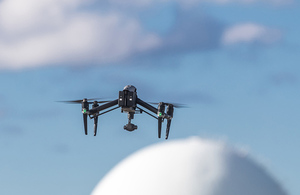Dounreay switches to drones
Dounreay is using drones to carry out inspection work on buildings.

Photo of drone
Drone technology is helping Dounreay reduce the risk of accidents and save money on its inspection of buildings. A camera mounted on an unmanned aerial vehicle is taking over tasks previously carried out by workers on elevated work platforms.
Falls from height are recognised as one of the biggest causes of death and serious injury in UK workplaces, so the switch to drone technology means staff can carry out inspections while keeping their feet firmly on the ground.
Dounreay Site Restoration Limited (DSRL), the company in charge of decommissioning the nuclear site, carries out about 50 inspections a year of buildings that continue to play an important role in clean-up and waste management functions. It estimates manpower savings of £100,000 as a result of the switch to drone technology.
John Moar, a senior electrical engineer at the site, is behind the initiative. His long-standing personal interest in aerial photography prompted research into whether drones could be deployed at the site, given it falls within a strictly enforced air exclusion zone and is protected by robust physical protection measures including armed officers from the Civil Nuclear Constabulary. After investigating the rules and technical requirements, including nuclear site regulations, he persuaded the company of the potential benefits in both health and safety as well as cost. John undertook a course run by a Civil Aviation Authority authorised training company and secured a specific exemption from the no-fly zone.
DSRL spent £6,000 on a drone – and John says the results so far have been very impressive. Its first deployment was to carry out an inspection of two 20-metre high stacks for a project to modernise the ventilation of a facility. Previously, this would have required the site to erect scaffolding and hire a mobile elevated work platform at a cost of thousands of pounds a week.
“The project manager was delighted at the quality and detail of the images and how easy and safe it was to get them,” said John. “It also gives us 360 degrees inspections, which often isn’t possible when doing the inspection manually. Clearly there are very strict rules in place to protect the safety and security of nuclear sites, so we had to follow a detailed process to get all required agreements.”
John is now passing on his skills to a team from the site’s maintenance department who are being trained by an authorised trainer to operate the drones. He says the images obtained from the aerial surveys will improve the quality of the site’s building maintenance programme and enhance professional structural surveys.
“It also has the potential to develop applications in other areas, such as 3D modelling, thermographic, environmental and land remediation surveys, and PR footage.”
Dounreay’s tallest structure is 55 metres high. The drone can fly up to heights of 120 metres.